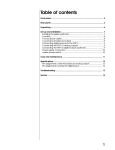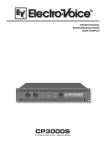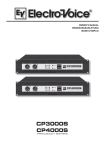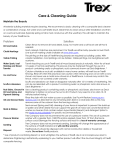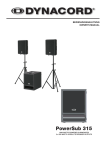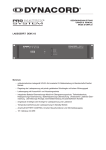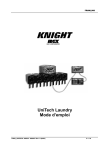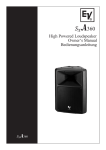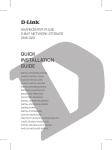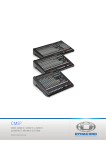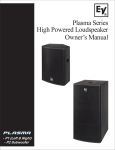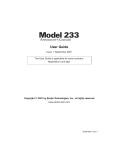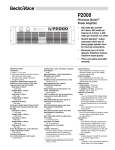Download 360 W HIGH EFFICIENCY 2 WAY ACTIVE CABINET
Transcript
BEDIENUNGSANLEITUNG OWNER‘S MANUAL MODE D’EMPLOI AM 12 360 W HIGH EFFICIENCY 2 WAY ACTIVE CABINET WICHTIGE SICHERHEITSHINWEISE Das Blitzsymbol innerhalb eines gleichseitigen Dreiecks soll den Anwender auf nicht isolierte Leitungen und Kontakte im Geräteinneren hinweisen, an denen hohe Spannungen anliegen, die im Fall einer Berührung zu lebensgefährlichen Stromschlägen führen können. 1. 2. 3. 4. 5. 6. 7. 8. 9. 10. 11. 12. 13. 14. 15. 16. Das Ausrufezeichen innerhalb eines gleichseitigen Dreiecks soll den Anwender auf wichtige Bedienungssowie Servicehinweise in der zum Gerät gehörenden Literatur aufmerksam machen. Lesen Sie diese Hinweise. Heben Sie diese Hinweise auf. Beachten Sie alle Warnungen. Richten Sie sich nach den Anweisungen. Betreiben Sie das Gerät nicht in unmittelbarer Nähe von Wasser. Verwenden Sie zum Reinigen des Gerätes ausschließlich ein trockenes Tuch. Verdecken Sie keine Lüftungsschlitze. Beachten Sie bei der Installation des Gerätes stets die entsprechenden Hinweise des Herstellers. Vermeiden Sie die Installation des Gerätes in der Nähe von Heizkörpern, Wärmespeichern, Öfen oder anderer Wärmequellen. Achtung: Gerät nur an Netzsteckdose mit Schutzleiteranschluss betreiben. Setzen Sie die Funktion des Schutzleiteranschlusses des mitgelieferten Netzanschlusskabels nicht außer Kraft. Sollte der Stecker des mitgelieferten Kabels nicht in Ihre Netzsteckdose passen, setzen Sie sich mit Ihrem Elektriker in Verbindung. Sorgen Sie dafür, dass das Netzkabel nicht betreten wird. Schützen Sie das Netzkabel vor Quetschungen insbesondere am Gerätestecker und am Netzstecker. Verwenden Sie mit dem Gerät ausschließlich Zubehör/Erweiterungen, die vom Hersteller hierzu vorgesehen sind. Ziehen Sie bei Blitzschlaggefahr oder bei längerem Nichtgebrauch den Netzstecker. Überlassen Sie sämtliche Servicearbeiten und Reparaturen einem ausgebildeten Kundendiensttechniker. Servicearbeiten sind notwendig, sobald das Gerät auf irgendeine Weise beschädigt wurde, wie z.B. eine Beschädigung des Netzkabels oder des Netzsteckers, wenn eine Flüssigkeit in das Gerät geschüttet wurde oder ein Gegenstand in das Gerät gefallen ist, wenn das Gerät Regen oder Feuchtigkeit ausgesetzt wurde, oder wenn es nicht normal arbeitet oder fallengelassen wurde. Stellen Sie bitte sicher, dass kein Tropf- oder Spritzwasser ins Geräteinnere eindringen kann. Stellen Sie keine mit Flüssigkeiten gefüllten Objekte, wie Vasen oder Trinkgefässe, auf das Gerät. Um das Gerät komplett spannungsfrei zu schalten, muss der Netzstecker gezogen werden. Beim Einbau des Gerätes ist zu beachten, dass der Netzstecker leicht zugänglich bleibt. Entsorgung von gebrauchten elektrischen und elektronischen Geräten (Anzuwenden in den Ländern der Europäischen Union und anderen europäischen Ländern mit einem separaten Sammelsystem für diese Geräte) Das Symbol auf dem Produkt oder seiner Verpackung weist darauf hin, dass dieses Produkt nicht als normaler Haushaltsabfall zu behandeln ist, sondern bei einem Telex Händler abgegeben werden muss. WICHTIGE SERVICEHINWEISE ACHTUNG: Diese Servicehinweise sind ausschliesslich für qualifiziertes Servicepersonal vorgesehen. Um die Gefahr eines elektrischen Schlages zu vermeiden, führen Sie keine Wartungsarbeiten durch, die nicht in der Bedienungsanleitung beschrieben sind, ausser Sie sind hierfür qualifiziert. Überlassen Sie sämtliche Servicearbeiten und Reparaturen einem ausgebildeten Kundendiensttechniker. 1. Bei Reparaturarbeiten im Gerät sind die Sicherheitsbestimmungen nach EN 60065 (VDE 0860) einzuhalten. 2. Bei allen Arbeiten, bei denen das geöffnete Gerät mit Netzspannung verbunden ist und betrieben wird, ist ein Netz trenntransformator zu verwenden. 3. Vor einem Umbau mit Nachrüstsätzen, Umschaltung der Netzspannung oder sonstigen Modifikationen ist das Gerät stromlos zu schalten. 4. Die Mindestabstände zwischen netzspannungsführenden Teilen und berührbaren Metallteilen (Metallgehäuse) bzw. zwischen den Netzpolen betragen 3 mm und sind unbedingt einzuhalten. Die Mindestabstände zwischen netzspannungsführenden Teilen und Schaltungsteilen, die nicht mit dem Netz verbunden sind (sekundär), betragen 6 mm und sind unbedingt einzuhalten. 5. Spezielle Bauteile, die im Stromlaufplan mit dem Sicherheitssymbol gekennzeichnet sind (Note), dürfen nur durch Originalteile ersetzt werden. 6. Eigenmächtige Schaltungsänderungen dürfen nicht vorgenommen werden. 7. Die am Reparaturort gültigen Schutzbestimmungen der Berufsgenossenschaften sind einzuhalten. Hierzu gehört auch die Beschaffenheit des Arbeitsplatzes. 8. Die Vorschriften im Umgang mit MOS - Bauteilen sind zu beachten. NOTE: SAFETY COMPONENT ( MUST BE REPLACED BY ORIGINAL PART ) 2 BESCHREIBUNG INHALTSVERZEICHNIS Beschreibung Quickstart Bedienelemente Verkabelung Aufbaubeispiele Technische Daten Block Diagramm Abmessungen ............................................................................... 3 ............................................................................... 4 ............................................................................... 5 ............................................................................... 8 ............................................................................... 23 ................................................................................ 24 ................................................................................ 25 ................................................................................ 25 Herzlichen Glückwunsch! Sie haben sich mit dem AM12 von DYNACORD für einen Aktiven Monitor modernster Technologie entschieden. Der AM12 ist ein aktives 2-Weg Lautsprechersystem welches für den Einsatz als Bühnenmonitor oder auch als Beschallungsanlage entwickelt wurde.Durch die vielfältigen Anschluß- und Einstellmöglichkeiten (MIC, LINE und AUX) werden Ihrer Kreativität keine Grenzen gesetzt. Sie können den AM12 problemlos als Monitor auf der Bühne, kleines PA-System oder als Beschallungsanlage für z.B. Präsentationen oder Veranstaltungen einsetzen.Durch die Verwendung hochwertiger Lautsprecherkomponenten und modernster Endstufentechnologie erzeugt der AM12 einen überdurchschnittlich hohen Schalldruck und bietet dabei ein Maximum an klanglicher Performance. Die eingebauten High Efficiency Endstufen mit 300W/4Ohm für den Lo Kanal und 60W /8Ohm für den HI Kanal stehen Ihnen bei allen Ihren Beschallungsaufgaben leistungsstark und zuverlässig zur Seite. An der Speakon-Buchse für Extension Speaker können Sie je nach Bedarf eine passive Monitorbox, wie die M12 oder einen Subwoofer anschließen.Um den Sound des AM12 an die jeweilige Anwendung bzw. akustische Umgebung anzupassen, haben Sie mit der integrierten Acoustic Processing Section alles unter Kontrolle. Auspacken und Garantie Öffnen Sie die Verpackung und entnehmen Sie den AM12. Ziehen Sie die Schutzfolie vom Griff ab. Es liegt noch zusätzlich zu dieser Bedienungsanleitung ein Netzkabel, eine Zugentlastung und die Garantiekarte bei. Überprüfen Sie bitte ob die Garantiekarte vollständig ausgefüllt ist, denn nur so können Sie etwaige Garantieansprüche geltend machen. Sie haben auf das Gerät 36 Monate Garantie, die ab dem Zeitpunkt der Aushändigung durch den Händler beginnt. Bewahren Sie zur Garantiekarte auch den Kaufbeleg, der den Termin der Übergabe festlegt, auf. Aufstellen und Anschließen Stellen Sie den AM12 immer mit den dafür vorgesehenen Gummifüßen auf eine ebene Unterlage, so daß eine sichere Arbeitslage gewährleistet ist. Der Kühlkörper auf der Geräterückseite darf beim Betrieb nicht abgedeckt werden. Der AM12 würde ansonsten durch thermische Überlastung in den Protect-Mode schalten. Das Gerät nimmt dadurch zwar keinen Schaden, aber die Wiedergabe wird bis zum Wiedereinschalten unterbrochen. Der Lautsprecherausgang (EXTENSION SPEAKER) auf der Rückseite des Gerätes ist mit professionellen SPEAKON-Hochlaststeckverbindungen ausgeführt. Diese Anschlußart stellt eine absolut sichere Verbindung zu einem Zusatzlautsprecher her. Die Belegung der Buchsen ist 1+(hot) und 1-(cold). Vor dem Anschließen ans Netz stellen Sie bitte fest, ob die am Gerät im Bereich des Netzschalters aufgedruckte Betriebsspannung Ihrer Netzspannung entspricht. Um das Netzkabel vor ungewolltem Herausziehen aus der Netzbuchse zu sichern, können Sie die dem Gerät beiliegende Zugentlastung montieren. Entfernen Sie hierzu die im Bild gezeigte Schraube. Schieben Sie die Zugentlastung über das Netzkabel und befestigen diese mit der Schraube an der AM12 Blende. 3 QUICKSTART Quickstart Bevor Sie den AM12 einschalten, drehen Sie bitte die Acoustic Processing Regler in Mittelstellung. Achtung: Drehen Sie vor dem Einschalten des AM12 die Level-Regler immer auf Linksanschlag. Andernfalls könnten Sie bei eingeschalteter Signalquelle sehr hohen Lautstärken ausgesetzt werden. Besondere Gefahr bedingt durch akustische Rückkopplung besteht bei bereits angeschlossenem Mikrofon. Sie können drei verschiedene Signalquellen an die Input Section des AM12 anschließen und zueinander Mischen. (MIC, LINE und AUX) MIC 1. Drehen Sie immer vor dem Anschließen eines Mikros den MIC GAIN-Regler auf Linksanschlag. 2. Verbinden Sie ein Mikrofon per XLR-Kabel mit dem MIC Eingang des AM12. 3. Nun schalten Sie das Mikro ein und drehen, während Sie in das Mikro sprechen, den MIC GAIN Regler langsam auf bis Sie eine ausreichende Lautstärke erreicht haben. Achtung: Bei zu hohen Pegeleinstellungen kommt es zu Rückkopplungen. Drehen Sie daher nur vorsichtig am MIC GAIN Regler. Die Koppelgrenze kann ggf. durch nach links drehen des MID-Reglers hinaufgesetzt werden. 4. Nun können Sie die Klangeinstellung mit Hilfe der HI-, MID- und LO-Regler entsprechend den akustischen Bedingungen anpassen. Achten Sie dabei wieder auf die Koppelgrenze. Beginnt das System bei einer Klangeinstellung zu koppeln, drehen Sie den entsprechenden Regler wieder ein Stück zurück. LINE IN 1. Drehen Sie immer vor dem Anschließen einer Signalquelle den LINE TRIM Regler auf Linksanschlag. 2. Verbinden Sie eine Signalquelle (z.B. Mixer, Keyboard etc.) per 6,3mm Klinkenkabel mit dem LINE IN des AM12. 3. Schalten Sie erst die Signalquelle ein und drehen dann den LINE TRIM Regler auf, bis die gewünschte Lautstärke erreicht ist. 4. Nun können Sie die Klangeinstellung mit Hilfe der HI-, MID- und LO-Regler an Ihre Wünsche anpassen. AUX IN 1. Drehen Sie immer vor dem Anschließen einer Signalquelle den AUX LEVEL Regler auf Linksanschlag. 2. Verbinden Sie eine Signalquelle (z.B. CD/MD-Player oder Tape-Deck) per Cinchkabel mit dem AUX IN des AM12. 3. Schalten Sie erst die Signalquelle ein und drehen dann den AUX LEVEL Regler auf, bis die gewünschte Lautstärke erreicht ist. 4. Nun können Sie die Klangeinstellung mit Hilfe der HI-, MID- und LO-Regler an Ihre Wünsche anpassen. 4 BEDIENELEMENTE MIC Elektronisch symmetrischer XLR-Eingang, zum Anschluß niederohmiger Mikrofone. Sie können hier im Prinzip jedes Mikrofon anstecken, sofern Sie dabei auf die PIN-Belegung achten. Sie können an diesem Eingang auch Kondensator-Mikrofone verwenden. Ihr Mikro wird dann vom AM12 mit Betriebsspannung (+24V) versorgt. Beachten Sie dazu bitte die Bedienungsanleitung Ihres Mikrofons. Achtung: Drehen Sie vor dem An- und Abstecken eines Mikros den GAIN-Regler auf Linksanschlag. Sie bewahren dadurch Ihre Umwelt und sich selbst vor eventuell auftretenden Knackgeräuschen oder Rückkopplungen. Der MIC Eingang ist nur bedingt für den Anschluß von Mischpulten, Keyboard oder anderen elektronischen Geräten geeignet. Benutzen Sie hierfür wenn möglich den LINE Eingang. MIC GAIN Mit diesem Regler stellen Sie die Lautstärke des angeschlossenen Mikrofons ein. Der Einstellbereich erstreckt sich von -∞ bis +40dB. Achtung: Bei sehr hohen Lautstärkeeinstellungen kann es zu unangenehmen Rückkopplungspfeifen kommen! LINE IN Elektronisch symmetrischer Eingang für hochpegeligen Signalquellen wie Mischpulte, elektronische Instrumente wie Keyboard, Gitarren und Bässe mit aktiver Elektronik.Der LINE Eingang kann sowohl symmetrisch als auch unsymmetrisch gespeist werden. Verwenden Sie hierzu Mono- bzw. Stereoklinkenkabel. Wenn das anzuschließende Gerät eine symmetrische Ausgangsstufe besitzt, ist in jedem Fall die symmetrische Signalführung mit Stereoklinkenkabel zu bevorzugen. Die Verbindung ist dann wesentlich unempfindlicher auf etwaige externe Brumm- und Hochfrequenzeinstreuung. Achtung: Drehen Sie vor dem An- und Abstecken eines Gerätes den LINE TRIM-Regler auf Linksanschlag. Sie bewahren dadurch Ihre Umwelt und sich selbst vor eventuell auftretenden Knackgeräuschen. LINE OUT An der LINE OUT Buchse liegt das Signal der LINE IN Buchse an. Verwenden Sie diesen Ausgang um das Signal an weitere Geräte mit LINE Eingängen durchschleifen. (z.B. zusätzlicher AM12) LINE TRIM Mit diesem Regler stellen Sie die Lautstärke des am LINE IN angeschlossenen Signals ein. Der Einstellbereich erstreckt sich von -∞ bis +6dB. 5 BEDIENELEMENTE AUX IN Sie können an den Cinch-Buchsen Stereo Signalquellen (z.B. CD/ MD-Player, Tape-Deck,...) anschließen. Die Signale für den rechten und linken Kanal werden intern summiert. Achtung: Drehen Sie vor dem An- und Abstecken eines Gerätes den AUX LEVEL-Regler auf Linksanschlag. Sie bewahren hiermit ihre Umwelt und sich selbst vor eventuell auftretenden Knackgeräuschen. AUX LEVEL Mit diesem Regler stellen Sie die Lautstärke des am AUX IN angeschlossenen Signals ein. ACOUSTIC PROCESSING Die ACOUSTIC PROCESSING Section ist keine herkömmliche Klangregelung wie sie z. B. in einem Mixer zu finden ist. Sie haben mit ihr die Möglichkeit den Sound des AM12 sehr effektiv an die akustische Umgebung anzupassen. Sie können mit den Reglern den Frequenzgang des AM12 in den im Bild unten dargestellten Grenzen verändern. Bei der Klangeinstellung sollten Sie immer von der Mittelstellung ausgehen und nur vorsichtig an den Klangreglern drehen. HI Regler Mit dem HI Regler können Sie die hochfrequenten Anteile des Signals bis zu 10dB anheben oder absenken. MID Regler Auf Rechtsanschlag steht der Mittenregler in Null Position, d.h. der Mittenbereich wird nicht abgesenkt. Auf Linksanschlag bewirkt er eine Absenkung um 6dB.Akustische Rückkopplungen vermeiden Sie wirksam mit Hilfe des MID Reglers. Die Einsatzfrequenz des MID-Reglers liegt bei 4 kHz. Dies ist erfahrungsgemäß der Frequenzbereich bei dem in den meisten Aufbausituationen erhöhte Rückkoplungsgefahr besteht. 12.000 9.0000 6.0000 3.0000 0.0 +12 +12 LO +6 MID 0 0 -3.000 HI 0 -3 -6.000 LO Regler Der LO-Regler ist über das patentierte Low Pass Notchfilter von DYNACORD realisiert.Mit dem LO Regler können Sie die tieffrequenten Anteile des Signals anheben. Auf Linksanschlag steht der LO Regler in Null Position, d.h. der Bassbereich wird nicht angehoben. Auf Rechtsanschlag bewirkt er eine Anhebung um 12dB. -6 -9.000 -12 -12.00 -15.00 -18.00 -21.00 20 100 1k 10k 20k 6 BEDIENELEMENTE STATUS ANZEIGEN Diese Anzeigen informieren Sie über den aktuellen Zustand der Leistungsverstärker im AM12. POWER leuchtet immer, wenn der AM12 eingeschaltet ist. Sollte die LED nach dem Einschalten nicht leuchten, prüfen Sie zuerst ob das Netzkabel angesteckt ist. Wenn dies der Fall ist und die LED trotzdem nicht leuchtet, kontaktieren Sie bitte ihren Fachhändler. LIMIT zeigt beim Aufleuchten an, daß Sie aktuell im Grenzbereich des Leistungsverstärkers fahren. Kurzzeitiges Aufleuchten ist unkritisch, da der Limiter im Leistungsverstärker Verzerrungen ausregelt. Dauerndes Aufleuchten könnte zu Klangeinbußen führen und sollte durch Reduzierung der Ausgangs- lautstärke vermieden werden. PROTECT leuchtet dann auf, wenn eine der umfangreichen Schutzschaltungen wie Übertemperatur-, Hochfrequenz-, Gleichspannungoder Back-EMF-Schutzschaltung im Leistungsverstärker aktiv ist. Um die Leistungsverstärker vor Zerstörung zu schützen, werden im Protect Mode die Lautsprecher über Relais abgeschaltet und der Eingang der Endstufe zurückgeregelt. Ist dies der Fall, überprüfen Sie bitte zuerst ob ein Kurzschluß am EXTENSION-SPEAKER Ausgang besteht. Entfernen Sie dazu ggf. das SPEAKON-Lautsprecherkabel vom Gerät. Eventuell haben Sie auch mehr als eine Box am Ausgang angeschlossen. Beim Einschalten des Gerätes wird die PROTECT LED für ca. 2 Sekunden aufleuchten. Dies ist normal und zeigt Ihnen, daß alle Schutzmechanismen aktiviert sind. POWER 1. Kaltgerätestecker zum Anschluß des Stromnetzes.2. Sicherungshalter für Netzsicherung.3. Netzschalter zum Ein- und Ausschalten des Gerätes. EXTENSION SPEAKER Fullrange Lautsprecherausgang zum Anschluß eines passiven Kabinets wie z.B. dem DYNACORD M12 oder C15SUB. Der Ausgang ist als professionelle SPEAKON-Hochlaststeckverbindung ausgeführt. Diese mechanisch und elektrisch sichere Verbindung wird allen Sicherheitsanforderungen gerecht und erlaubt die Verwendung von Hochleistungslautsprecherkabeln von bis zu 4 x 2,5mm² Querschnitt.Am Extension SPEAKER-Ausgang darf maximal eine Zusatzbox mit 8 Ohm Impedanz angeschlossen werden. Der Anschluß von mehreren Kabineten wird zwar die interne Endstufe nicht beschädigen, kann aber zum Ansprechen der Schutzschaltung führen. Warnung: Das Symbol , das die Lautsprecheranschlüsse markiert, zeigt an, daß hier Spannungen anliegen, die dem Anwender bei Berührung gesundheitlichen Schaden zufügen können. Befolgen Sie daher zum Anschluß von Lautsprechern stets die entsprechenden Hinweise in der Bedienungsanleitung. Im DYNACORD-Zubehörprogramm finden Sie Einzelstecker und Kupplungen sowie Hochleistungslautsprecherkabel. 7 VERKABELUNG Lautsprecherkabel Aus unserer Erfahrung stellt eine Gummischlauchleitung mit 2.5mm2 Querschnitt je Ader in Verbindung mit SPEAKON Steckern und Buchsen die optimale Verkablungsart für Lautsprecher dar. Die SPEAKON-Stecker werden entsprechend dem Schaubild an der Rückseite des AM12 angeschlossen, Lautsprecherkabel mit SPEAKON Steckern können Sie über den Fachhandel aus dem DYNACORD- Zubehörprogramm beziehen. Auch alle anderen Kabel und Stecker sind dort erhältlich. NF-Verbindungskabel Zum Anschluß Ihrer Signalquellen sollten Sie nach Möglichkeit symmetrisch ausgelegte Kabel mit XLR- oder Stereoklinkenstecker verwenden. Die symmetrische Verkabelung reduziert in hohem Maße Probleme durch Einstreuung von Störgeräuschen. Achten Sie auf jeden Fall auf die unten abgebildete Anschlußbelegung der Steckverbinder. Kabel aus dem DYNACORD Zubehörsortiment werden in jedem Fall dieser Belegung entsprechen. XLR FEMALE XLR MALE Mikrofone symmetrisch Unsymmetrisch Externe Geräte mit XLR Ein- und Ausgangsbuchsen Symmetrisch Unsymmetrisch Externe Geräte mit Klinken Ein- und Ausgangsbuchsen Symmetrisch 8 IMPORTANT SAFETY INSTRUCTIONS The lightning flash with arrowhead symbol, within an equilateral triangle is intended to alert the user to the presence of uninsulated „dangerous voltage“ within the product’s enclosure that may be of sufficient magnitude to constitute a risk of electric shock to persons. The exclamation point within an equilateral triangle is intended to alert the user to the presence of important operating and maintance (servicing) instructions in the literature accompanying the appliance. 1. 2. 3. 4. 5. 6. 7. 8. 9. 10. 11. 12. 13. 14. 15. 16. Read these instructions. Keep these instructions. Heed all warnings. Follow all instructions. Do not use this apparatus near water. Clean only with a dry cloth. Do not cover any ventilation openings. Install in accordance with the manufacture’s instructions. Do not install near heat sources such as radiators, heat registers, stoves, or other apparatus (including amplifiers) that produce heat. Do not defeat the safety purpose of the polarized or the grounding-type plug. A polarized plug has two blades with one wider than the other. A grounding type plug has two blades and a third grounding prong. The wide blade or the third prong are provided for your safety. If the provided plug does not fit into your outlet, consult an electrican for replacement of the obsolete outlet. Protect the power cord from being walked on or pinched particularly at plugs, convenience receptacles, and the point where they exit from the apparatus. Only use attachments/accessories specified by the manufacturer. Unplug this apparatus during lightning storms or when unused for a long period of time. Refer all servicing to qualified service personnel. Servicing is required when the apparatus has been damaged in any way, such as power-supply cord or plug is damaged, liquid has been spilled or objects have fallen into the apparatus, the apparatus has been exposed to rain or moisture, does not operate normally, or has been dropped. Do not expose this equipment to dripping or splashing and ensure that no objects filled with liquids, such as vases, are placed on the equipment. To completely disconnect this equipment from the AC Mains, disconnect the power plug from the AC receptacle. The mains plug of the power supply cord shall remain readily operable. Management of WEEE (waste electrical and electronic equipment) (applicable in Member States of the European Union and other European countries with individual national policies on the management of WEEE) The symbol on the product or on its packaging indicates that this product may not be treated as regular household waste, but has to be disposed through returning it at a Telex dealer. IMPORTANT SERVICE INSTRUCTIONS CAUTION: 1. 2. 3. 4. 5. 6. 7. 8. These servicing instructions are for use by qualified personnel only. To reduce the risk of electric shock, do not perform any servicing other than that contained in the Operating Instructions unless you are qualified to do so. Refer all servicing to qualified service personnel. Security regulations as stated in the EN 60065 (VDE 0860 / IEC 65) and the CSA E65 - 94 have to be obeyed when servicing the appliance. Use of a mains separator transformer is mandatory during maintenance while the appliance is opened, needs to be operated and is connected to the mains. Switch off the power before retrofitting any extensions, changing the mains voltage or the output voltage. The minimum distance between parts carrying mains voltage and any accessible metal piece (metal enclosure), respectively between the mains poles has to be 3 mm and needs to be minded at all times. The minimum distance between parts carrying mains voltage and any switches or breakers that are not connected to the mains (secondary parts) has to be 6 mm and needs to be minded at all times. Replacing special components that are marked in the circuit diagram using the security symbol (Note) is only permissible when using original parts. Altering the circuitry without prior consent or advice is not legitimate. Any work security regulations that are applicable at the location where the appliance is being serviced have to be strictly obeyed. This applies also to any regulations about the work place itself. All instructions concerning the handling of MOS - circuits have to be observed. NOTE: SAFETY COMPONENT ( MUST BE REPLACED BY ORIGINAL PART ) 9 DESCRIPTION TABLE OF CONTENTS Description Quick Start Controls Cabling Setup Examples Specifications Block Diagramm Dimensions ..............................................................................10 ..............................................................................11 ..............................................................................12 ..............................................................................15 ..............................................................................23 ..............................................................................24 ..............................................................................25 ..............................................................................25 Congratulations! With buying the DYNACORD AM12 you got yourself an active monitor system that incorporates most advanced technology. The AM12 is an active 2-way loudspeaker system that has been designed for use in stage-monitoring or general sound reinforcement applications. The multitude of connection and setting facilities (MIC, LINE, and AUX) allows using the AM12 in many creative ways. You can use the AM12 as on-stage monitor speaker, small PA system or even for sound reinforcement during presentations and similar events. Employing only quality speaker components and a sophisticated modern power amplifier design, the AM12 generates outstandingly high sound pressure level offering maximum sound performance. The integrated high-efficiency power amps provide 300W/4ohms for the Lo range channel and 60W/8ohms for the Hi range channel, supplying sufficient output power and reliable operation for all your sound reinforcement applications. The Extension Speaker Speakon-type connector allows connecting an additional passive monitor, like the M12 or an external subwoofer and using the integrated Acoustic Processing Section provides all the controls you need to adjust the AM12’s sound to individual applications or acoustic conditions. Unpacking and Warranty Open the package and carefully take out the AM12. Remove the protection foil from the handle of the appliance. Next to this owner’s manual the package also contains the mains cord, a cable pull-relief and the warranty card. Please check whether the warranty card has been filled out entirely. Only a warranty card with completely filled in information entitles you to make any warranty claims. The appliance comes with a full 36 months warranty that is valid from the date of original purchase. Please also keep the original invoice together with the warranty card. Setup and Connections To ensure safe and reliable operation, always place the AM12 on an even surface standing on its rubber foot stands. Do not cover the heat sink on the rear of the appliance during operation. Otherwise, the AM12 will enter protect-mode because of thermal overload. This prevents the system from being damaged but the sound reproduction is suspended until the system regains operational state. The speaker output (EXTENSION SPEAKER) on the rear of the appliance is carried out via professional SPEAKON-type high-performance connectors, which provide absolutely secure and reliable connection of additional speakers. The pin-assignment of the female-type connectors is 1+(hot) and 1-(cold). Before connecting the AM12 to the mains, please make sure that the value stated on the mains voltage label which is located next to the appliance’s mains switch, complies to the voltage settings of your local power supply. Installing the supplied cable pull-relief prevents that the mains cord gets inadvertently pulled out of the mains socket. For installing the cable pull-relief, please remove the screw as shown in the diagram. Slide the cable pull-relief over the mains cord and use the screw to fix it to the AM12 panel. 10 QUICK START Please set all Acoustic Processing controls to their center position, before switching the AM12’s power on. Caution: Before switching the AM12’s power on, make sure to set the level controls to their counterclockwise margin. Otherwise, this could result in extremely high acoustic output, especially when the connected audio source is already playing. It is particularly dangerous when a microphone is connected, because of the possibility of acoustic feedback. The input section of the AM12 allows the connection and mixing of three individual audio signal sources (MIC, LINE, and AUX). MIC 1. Before connecting a microphone, turn the MIC GAIN control all the way down (counterclockwise). 2. Connect a microphone via XLR-type cable to the MIC input of the AM12. 3. Switch the microphone on and while speaking into the mic slowly increase the MIC GAIN setting until the wanted volume is achieved. Caution: Too high level setting can result in acoustic feedback. Therefore be careful when turning the MIC GAIN control. Under some circumstances it is possible to increase the feedback threshold by lowering the mid range level using the MIDs control. 4. Using the HI, MID, and LO controls lets you match the sound according to acoustical conditions. Again, be sure to keep the feedback threshold in mind. Whenever you notice feedback noise after making a certain change, decrease the setting of the control that you have just used by a little bit. LINE IN 1. Before connecting an audio signal source, always turn the LINE TRIM control all the way down (counterclockwise). 2. Connect an audio signal source (e.g. mixer, keyboard, etc.) to the AM12’s LINE IN connector using a 0.25-inch phone plug. 3. First, switch on the audio source and then slowly increase the setting of the LINE TRIM control until the desired volume is achieved. 4. Using the HI, MID, and LO controls lets you match the sound to your liking. AUX IN 1. Before connecting an audio signal source, always turn the AUX LEVEL TRIM control all the way down (counterclockwise). 2. Connect an audio signal source (e.g. CD/MD-Player or Tape Deck) to the AM12’s AUX IN using a RCA connector-type cable. 3. Switch on the audio source and then slowly increase the setting of the AUX TRIM control until the desired volume is achieved. 4. Using the HI, MID, and LO controls lets you match the sound to your liking. 11 CONTROLS MIC is an electronically balanced XLR-type input for connecting low-impedance microphones. Basically, you are able to connect any type of microphone to this input as long as you mind the correct pin-assignment. It is also possible to connect condenser microphones, which automatically gets the needed phantom power (+24V) from the AM12. Please also refer to your microphone’s owner’s manual for additional information. Caution: Before connecting or unplugging a microphone, make sure to turn the GAIN control all the way down (counterclockwise). This helps to protect the audience and you from unpleasing knack noise. The MIC-input is not necessarily meant for the connection of mixers, keyboard instruments or other electronic sound generating sources. For better results, please use the den LIN-input instead. MIC GAIN This control is used to set the volume of the connected microphone within an adjustment range of -∞ to +40dB. Caution: Extremely high volume setting may result in unpleasing feedback noise! LINE IN is an electronically balanced input for connecting high-impedance audio signal sources like mixers, electronic music instruments like keyboards, guitars and bass guitars with built-in active electronics. It is possible to connect balanced as well as unbalanced gear at the LINE-input using monaural or stereo phone plug cables. Balanced connection via stereo phone plug cables is preferable whenever the source unit has a balanced output stage. Following this advice will provide you with the advantage of less interference that is introduced from external hum of HF-induction. Caution: Before connecting or unplugging devices, make sure to turn the LINE TRIM control all the way down (counterclockwise). This helps to protect the audience and you from unpleasing knack noise. LINE OUT The LINE OUT socket provides the carried through audio signal from the LINE IN connector. It can be used to feed additional external equipment (e.g. an additional AM12) with the identical input signal. LINE TRIM This control serves for setting the input level of the signal source that is connected to LINE IN within an adjustment range of -∞ to +6dB. 12 CONTROLS AUX IN These RCA-type connectors allow the connection of stereo signal sources (e. g. CD/MD-Player, Tape Deck,...). The stereo input signals are internally summed for monaural output. Caution: Before connecting or unplugging an appliance, make sure to turn the AUX LEVEL control all the way down (counterclockwise). This helps to protect the audience and you from unpleasing knack noise. AUX LEVEL This control is used to adjust the input level of the signal source that is connected to AUX IN. ACOUSTIC PROCESSING The ACOUSTIC PROCESSING section is not what you would call the ‘usual’ sound control section, like the ones found on a mixer for instance. What’s more, the ACOUSTIC PROCESSING section provides the possibility to very efficiently match the desired sound of the AM12 to existing acoustic conditions. Using the controls lets you alter the AM12’s frequency response up to the margins as shown in the below diagram. When altering the sound, it is always good advice to start with all controls set to their neutral positions - all controls centered - and to adjust their setting by cautiously turning the controls. HI control The HI control allows amplifying or attenuating the high-frequency range of the signal by ±10dB. MID control Turned all the way to the right (clockwise), the MID control is set to its neutral position, i.e. the signal’s mid-frequency range is unaltered. Set the control to its counterclockwise margin for 6dB attenuation. Therefore the MID control provides a way to efficiently prevent acoustic feedback noise. The MID control’s cutoff frequency is at 4 kHz. Experience has shown that with most set-ups in this frequency range feedback noise tends to occur. 12.000 9.0000 6.0000 3.0000 0.0 +12 +12 LO +6 MID 0 0 -3.000 HI 0 -3 -6.000 -6 -9.000 -12 -12.00 LO control The LO control incorporates the DYNACORD’s patented LoPass notch filter. Using the LO control lets you increase the audio signal’s low frequency range level. The signal is unaltered when the LO control is set to its neutral position, i.e. turned all the way down (counterclockwise). Setting the control to its clockwise margin causes a level increase of 12dB. -15.00 -18.00 -21.00 20 100 1k 10k 20k 13 CONTROLS STATUS INDICATORS These indicators provide information about the integrated power amplifier’s actual status. When the AM12 is powered-on, the POWER will light. In case the LED does not light after switching the power on please make sure that the mains cord is plugged in correctly. When the POWER LED still does not light although the mains connection is correct, please contact your dealer. When the LIMIT LED lights, this is an indication that the power amplifier is operated at its limit. Short-term blinking is not critical, since the integrated limiter circuit controls occurring distortion within the power amplifier. When the LED is constantly lit, this can result in sound degradation and you should reduce the output level. The PROTECT LED will light when one of the power amplifier’s comprehensive protection circuits like the temperature overload protection, HFprotection, DC-protection, and the Back-EMF-protection is activated. In Protect Mode, the loudspeaker outputs are muted via the speaker relays and the audio signal’s input level is automatically attenuated to protect the power amps from being damaged. When the AM12 enters Protect Mode, first check the EXTENSION SPEAKER output for existing shortcircuits. If necessary unplug the SPEAKON-type loudspeaker cable from the appliance. Maybe you have connected more than one speaker cabinet to the output.When switching the power of the AM12 on, the PROTECT LED will light for approximately 2 seconds. This is normal, indicating that the entire protection circuitry is operational. POWER 1. Mains connection via rubber connector 2. Mains fuse socket 3. Mains-switch for Power-On/Off EXTENSION SPEAKER Full-range loudspeaker output for the connection of passive cabinets like the DYNACORD M12 or C15SUB. The output is carried out as a professional standard SPEAKON high-performance connection. This mechanical and electrical secure connection complies with all safety standards allowing the use of high-quality speaker cables with diameters of up to 4 x 2.5mm. The Extension SPEAKER output provides the possibility for connecting a single cabinet with an impedance of 8 ohms. Connecting several cabinets does not necessarily cause damage to the integrated power amplifier but it might activate the internal protection circuitry. WARNING: The speaker output terminals are marked with a symbol “ ”, which signifies that these terminals present a shock hazard to the user. Make connections to these terminals as described in the owner’s manual. Plugs, jacks, and high-quality loudspeaker cables are available from DYNACORD’s accessory assortment. 14 CABLING CABLING Loudspeaker cable - Experience has shown that cable with rubber jacket, a diameter of 2.5mm2 per conductor, and SPEAKON-type plugs and jacks represent the optimal speaker connection solution. Connect the SPEAKON-type connectors on the rear panel of the AM12 according to the example in the diagram. DYNACORD loudspeaker cables that have SPEAKON-type connectors as well as any other types of cable are available from your dealer. LF-cord For connecting audio signal sources to the AM12, we recommend using cable with balanced XLR-type or stereo phone plug connectors. Using balanced cable reduces the risk of sound degradation resulting from interference. However, make sure to mind the pin-assignment as shown below. Original DYNACORD cable from our accessory program will always comply with this pin-assignment. XLR FEMALE XLR MALE balanced connection of microphones unbalanced external equipment with XLRtype in/output jacks balanced unbalanced external equipment with XLRtype in/output jacks balanced 15 INSTRUCTIONS DE SÉCURITÉ IMPORTANTES Le symbole représentant un éclair fléché dans un triangle équilatéral a pour but d’alerter l’utilisateur de la présence d’une „tension dangereuse“ non isolée à l’intérieur du boîtier, pouvant être d’une force suffisante pour constituer un risque d’électrocution. Le point d’exclamation dans un triangle équilatéral a pour but d’alerter l’utilisateur de la présence d’instructions importantes concernant le fonctionnement et la maintenance, dans la documentation qui accompagne l’appareil. 1. 2. 3. 4. 5. 6. 7. 8. 9. 10. 11. 12. 13. 14. 15. 16. Veuillez lire ces instructions avant d’installer l’appareil. Conservez ces instructions. Respectez tous les avertissements Suivez ces instructions. N’utilisez pas cet appareil près de l’eau. Nettoyez-le uniquement avec un chiffon sec. N’obstruez pas les ouïes de ventilation. Installez-le selon les instructions du fabricant. Ne l’installez pas près d’une source de chaleur telles que des radiateurs, des poêles, une étuve, ou autres appareils (dont les amplificateurs) produisant de la chaleur. Ne pas utiliser d’adaptateur risquant de supprimer la mise à la masse. Une prise polarisée est munie de deux lames, l‘une étant plus large que l‘autre. Sur une prise à trois fiches, deux sont des fiches secteur, la troisième est pour la terre. Cette fiche sert pour la sécurité. Si la prise fournie ne rentre pas dans votre prise de courant, demandez à un électricien de replacer cette prise obsolète. Protégez le cordon secteur afin que personne ne puisse marcher dessus, ni le tordre excessivement, surtout au niveau de la prise et à sa sortie de l’appareil. N’employez que des accessoires spécifiés par le fabricant. Débranchez l’appareil du secteur pendant les orages ou s’il doit rester inutilisé pendant longtemps. Adressez-vous à un service technique qualifié. Une révision est nécessaire si l‘appareil a été endommagé d‘une quelconque manière, par exemple si le cordon ou la prise secteur a été endommagé, si un liquide a été renversé ou si des objets sont tombés à l‘intérieur, ou encore si l‘appareil a été exposé à la pluie ou à l‘humidité, s‘il ne fonctionne pas normalement ou s‘il a subi une chute. N’exposez pas cet appareil aux éclaboussures et assurez-vous qu’aucun récipient contenant du liquide, tel que vase, ou verre ne soit posé dessus. Pour débrancher complètement l’appareil du secteur il faut débrancher le cordon secteur de la prise électrique. La prise du cordon secteur doit toujours être accessible. Gestion du REEE (recyclage des équipements électriques et électroniques) (applicable dans les états membres de l‘Union Européenne et autres pays Européens, avec des réglementations nationales spécifiques sur la gestion du REEE). Le symbole apposé sur le produit ou sur son emballage indique que ce produit ne peut pas être traité comme un déchet domestique normal, mais doit être conditionné et retourné à son revendeur d’origine. INSTRUCTIONS DE RÉPARATION IMPORTANTES CAUTION: 1. 2. 3. 4. 5. 6. 7. 8. Ces instructions de réparation ne s‘adressent qu‘à un personnel qualifié. Afin de réduire le risque d‘électrocution, ne pas procéder à des réparations autres que celles mentionnées dans les Instructions de Fonctionnement à moins que vous ne soyez qualifié pour le faire. Faites faire les réparations par un personnel qualifié. La règlementation concernant la sécurité stipulée dans les articles EN 60065 (VDE 0860 / IEC 65) et CSA E65 - 94 doit être respectée lors des réparations. L’utilisation d’un transformateur d’isolation est obligatoire pendant la maintenance lorsque l‘appareil est ouvert et qu‘il doit fonctionner en étant branché sur le secteur. Mettez l’appareil hors tension avant d’installer des extensions, de changer la tension secteur ou la tension de sortie. La distance minimum entre des éléments conduisant la tension secteur et toute pièce de métal accessible (boîtier métallique), doit toujours être de 3 mm et ce impérativement. La distance minimum entre des éléments véhiulant une tension secteur et tout commutateur ou interrupteur n‘étant pas connecté au courant secteur (pièces secondaires) doit toujours être de 6 mm et ce impérativement. Le remplacement des composants spéciaux qui sont marqués d’un symbole de sécurité (voir Note) dans le schéma de principe n‘est autorisé qu‘en employant des pièces d‘origine. Il n’est pas permis de modifier les circuits sans consentement ou avis préalable La règlementation concernant la sécurité du travail applicable dans le pays où l‘appareil est réparé doit être strictement observée. Ceci s‘applique également à toute règlementation du travail sur le lieu lui-même. Toutes les instructions concernant la manipulation des circuits MOS doivent être respectées. REMARQUE: COMPOSANT DE SÉCURITÉ (DOIT ÊETRE REMPLACÉ PAR UNE PIÈCE D‘ORIGINE) 16 DESCRIPTION TABLE DES MATIÈRES Description .......................................................................................17 Prise en main .......................................................................................18 Contrôles .......................................................................................19 Câblage .......................................................................................................22 Exemples de configuration .......................................................................23 Caractéristiques .......................................................................................24 Schéma de principe .......................................................................25 Dimensions .......................................................................................25 Félicitations ! En choisissant le DYNACORD AM12 vous venez d’acquérir un système d’enceintes actif qui incorpore la technologie actuelle la plus élaborée. L’AM12 est un système de haut-parleurs 2 voies actif qui a été conçu pour des applications de retours de scène ou de sonorisation en général. La multitude de possibilités de connexion et de réglages (MIC, LINE, et AUX) permet l’emploi de l’AM12 de diverses manières créatives. Vous pouvez utiliser l’AM12 comme haut-parleur de retour de scène, petit système de sonorisation ou même pour sonoriser des représentations et autres événements. Grâce à des composants de haut-parleurs de qualité et à un amplificateur de puissance de conception moderne et sophistiquée, l’AM12 peut générer des niveaux de pression sonore étonnants et offrir des performances sonores maximum. Les amplis de puissance intégrés, d’une grande efficacité, fournissent une puissance de 300 W/4 ohms pour les basses et de 60 W/8 ohms pour les aigus, ce qui autorise une puissance en sortie suffisante et un fonctionement fiable pour toutes vos applications de sonorisation. Le connecteur d’extension haut-parleur de type Speakon permet de brancher un autre haut-parleur passif, comme le M12 ou un subwoofer externe, et grâce à la section de traitement acoustique (Acoustic Processing) intégrée, vous disposez de tous les contrôles nécessaires pour adapter le son de l’AM12 à vos applications spécifiques ou aux conditions acoustiques. Mise en service et garantie Ouvrez le carton d’emballage et manipulez avec soin votre AM12. Enlevez la feuille de protection de la poignée de l’appareil. En plus de ce mode d’emploi, se trouvent également dans le carton, le cordon d’alimentation, un câble avec verrouillage de sûreté et la carte de garantie. Veuillez vérifier que la carte de garantie a été entièrement remplie. Seule une carte de garantie comportant tous les renseignements vous permettra de faire des réclamations. Cet appareil dispose d’une garantie de 36 mois valable à partir de la date d’achat d’origine de l’appareil. Veuillez également conserver un original de la facture avec la carte de garantie. Configuration et connexions Afin d’assurer un fonctionnement fiable en toute sécurité, placez toujours l’AM12 sur une surface plane, afin qu’il repose sur ses pieds en caoutchouc. N’obstruez pas l’évacuation de chaleur située à l’arrière de l’appareil, pendant son fonctionnement. Sinon, l’AM12 passerait en mode Protection du fait de son échauffement. Cette protection évite d’endommager le système, mais la production sonore est interrompue jusqu’à ce que le système retrouve son état de fonctionnement normal. La sortie haut-parleur (EXTENSION SPEAKER) située à l’arrière de l’appareil est munie de connecteurs professionnels de type SPEAKON à haute performance, qui fournissent une connexion absolument sure et fiable pour des haut-parleurs supplémentaires. L’assignation des broches des connecteurs femelles est 1+ (point chaud) et 1- (point froid).Avant de brancher l’AM12 sur le secteur, veuillez vous assurer que la tension mentionnée sur l’étiquette collée près de l’interrupteur secteur, sur l’appareil, correspond au réglage de la tension locale. Installez le câble avec verrouillage de sûreté fourni afin d’éviter que le cordon secteur ne soit débranché par inadvertance de la prise secteur. Pour installer le câble avec verrouillage de sûreté, il faut retirer la vis, comme indiqué sur le schéma. Insérez le câble dans le bon sens sur le cordon secteur, puis utilisez la vis pour le fixer au panneau de l’AM12. 17 PRISE EN MAIN Prise en main Réglez tous les contrôles de la section Acoustic Processing en position centrale, avant de mettre l’AM12 sous tension. Attention : Avant de mettre l’AM12 sous tension, veillez à régler tous les contrôles de niveau au plus bas (en les tournant à fond dans le sens contraire des aiguilles d’une montre). Sinon, vous risquez de provoquer un bruit extrêmement fort, surtout en connectant une source audio qui émet déjà. C’est particulièrement dangereux lorsqu’un microphone est connecté, du fait de la possibilité d’accrochages acoustiques. la section d’entrée de l’AM12 permet la connexion et le mixage de trois signaux audio séparés (MIC, LINE, et AUX). MIC 1. Avant de brancher un microphone, baissez complètement le contrôle MIC GAIN (dans le sens contraire des aiguilles d’une montre). Connectez le microphone au moyen d’un câble de type XLR à l’entrée MIC de l’AM12. Allumez le microphone et tout en parlant dans le micro montez doucement le réglage MIC GAIN jusqu’à obtenir le volume adéquat. 2. 3. Attention : Un réglage de volume trop élevé peut provoquer des accrochages. Donc, faites attention lorsque vous réglez le contrôle MIC GAIN. Dans certains cas, il est possible de repousser le seuil d’accrochage en réduisant le niveau des médium au moyen du contrôle MID. 4. Grâce aux contrôles HI, MID, et LO vous pouvez adapter le son aux conditions acoustiques. Là aussi, pensez au seuil d’accrochage. Chaque fois que vous constatez un bruit d’accrochage après avoir effectué un certain réglage, c’est qu’il faut diminuer légèrement le réglage du contrôle que vous venez d’actionner. LINE IN (Entrée Ligne) 1. Avant de connecter un signal audio, baissez complètement le contrôle LINE TRIM (dans le sens contraire des aiguilles d’une montre). Connectez la source de signal audio (par ex. une console, un clavier, etc.) au connecteur LINE IN de l’AM12 au moyen d’un jack 6,35 mm. Commencez par mettre la source audio sous tension, puis montez lentement le contrôle LINE TRIM jusqu’à obtenir le volume adéquat. Grâce aux contrôles HI, MID, et LO vous pouvez régler le son à votre convenance. 2. 3. 4. AUX IN 1. Avant de connecter un signal audio, baissez complètement le contrôle AUX LEVEL TRIM (dans le sens contraire des aiguilles d’une montre). Connectez la source de signal audio (par ex. un lecteur de CD/MD ou une platine cassette) au connecteur AUX IN de l’AM12 au moyen d’un câble de type RCA. Mettez la source audio sous tension, puis montez le contrôle AUX TRIM jusqu’à obtenir le volume adéquat. Grâce aux contrôles HI, MID, et LO vous pouvez régler le son à votre convenance. 2. 3. 4. 18 CONTROLES MIC Ce connecteur d’entrée de type XLR symétrisé électroniquement sert au branchement de microphones basse impédance. Normalement, vous pouvez y connecter n’importe quel type de microphone tant que vous conservez une assignation correcte des broches. Vous pourrez aussi y connecter des microphones à condenseur, qui déclenchent automatiquement l’alimentation fantôme adéquate (+24V) sur l’AM12. Veuillez également consulter le mode d’emploi de votre microphone pour de plus amples informations. Attention: Avant de brancher ou débrancher un microphone, vérifiez que le contrôle de GAIN est complètement baissé (dans le sens contraire des aiguilles d’une montre), afin de vous épargner, ainsi qu’à votre auditoire, des claquements déplaisants. L’entrée MIC n’est pas vraiment destinée à la connexion de consoles, instruments à clavier ou autres sources de génération sonore électronique. Pour de meilleurs résultats, il faut mieux utiliser l’entrée LIN. MIC GAIN Ce contrôle sert à régler le volume du microphone connectée selon des valeurs allant de -∞ à +40dB. Attention : Des réglages de volume extrêmement élevés peuvent provoquer des accrochages désagréables ! LINE IN Il s’agit d’une entrée symétrisée électroniquement pour la connexion de sources audio haute impédance tels que consoles, instruments de musique électroniques, comme les claviers, guitares et basses équipés d’une électronique active. Il est possible de connecter des appareils symétrisés ou non dans l’entrée LINE au moyen de câbles munis de prises mono ou stéréo. Une connexion symétrisée via des câbles stéréo est préférable chaque fois que l’appareil source a lui-même un étage de sortie symétrisé. En suivant ce conseil, vous aurez l’avantage de réduire les interférences dues au souffle externe de l’induction HF. Attention : Avant de brancher ou de débrancher des appareils, baissez complètement le contrôle LINE TRIM (dans le sens contraire des aiguilles d’une montre), afin de vous épargner, ainsi qu’à votre auditoire, des claquements déplaisants. LINE OUT La prise LINE OUT restitue le signal audio provenant du connecteur LINE IN. Elle peut servir à alimenter d’autres appareils externes (par ex. un autre AM12) avec le même signal d’entrée. LINE TRIM Ce contrôle sert à régler le niveau d’entrée de la source du signal connectée à la prise LINE IN selon des valeurs allant de -∞ à +6dB. 19 CONTROLES AUX IN Ces connecteurs de type RCA permettent la connexion de sources de signal stéréo (par ex. un lecteur de CD/MD ou une platine cassette,...). Les signaux d’entrée stéréo sont cumulés en interne pour la sortie mono. Attention: Avant de brancher ou débrancher un appareil, baissez complètement le contrôle AUX LEVEL (dans le sens contraire des aiguilles d’une montre), afin de vous épargner, ainsi qu’à votre auditoire, des claquements déplaisants. AUX LEVEL Ce contrôle sert à régler le niveau d’entrée de la source du signal connectée à la prise AUX IN. ACOUSTIC PROCESSING La section ACOUSTIC PROCESSING (Traitement acoustique) n’est pas exactement ce que l’on appelle “habituellement” une section de contrôle du son, comme celles que l’on trouve sur les consoles par exemple. C’est bien plus que cela, la section ACOUSTIC PROCESSING vous donne la possibilité d’adapter de manière très efficace le son de l’AM12 aux conditions acoustiques particulières du lieu. Grâce à ces contrôles, vous pouvez modifier la réponse en fréquence de l’AM12 dans les limites indiquées sur le schéma ci-dessous. Lorsque vous intervenez sur le son, il vaut mieux toujours commencer avec tous les contrôles réglés en position neutre - tous au centre - puis procéder aux réglages avec précaution en tournant progressivement ces contrôles. Contrôle HI (aigus) Le contrôle HI permet d’accentuer ou d’atténuer la bande des fréquences hautes du signal de ±10dB. 12.000 9.0000 6.0000 3.0000 0.0 Contrôle MID (médium) En le tournant complètement à droite (dans le sens des aiguilles d’une montre), le contrôle MID se retrouve en position neutre, c’està-dire que les fréquences moyennes du signal ne sont pas modifiées. Tournez ce contrôle à fond dans le sens contraire des aiguilles d’une montre pour obtenir une atténuation de 6dB. Ainsi le contrôle MID fournit un moyen très efficace de lutter contre les accrochages. La fréquence de coupure du contrôle MID est réglée sur 4 kHz. L’expérience montre qu’avec la plupart des configurations c’est dans cette bande de fréquence que les accrochages se produisent. +12 +12 LO +6 MID 0 0 -3.000 HI 0 -3 -6.000 -6 -9.000 -12 -12.00 Contrôle LO (graves) Le contrôle LO est muni du filtre Notch (ou coupe bande) passe-bas, breveté par DYNACORD. Grâce au contrôle LO vous pouvez accentuer les fréquences basses du signal audio. Le signal reste inchangé lorsque le contrôle LO est en position neutre, c’est-à-dire complètement fermé (dans le sens contraire des aiguilles d’une montre). Tournez ce contrôle à fond dans le sens des aiguilles d’une montre pour obtenir une augmentation de niveau de 12dB. -15.00 -18.00 -21.00 20 100 1k 10k 20k 20 CONTROLES INDICATEURS D’ÉTAT Ces indicateurs donnent des informations sur l’état actuel de l’amplificateur de puissance intégré.Lorsque l’AM12 est mis sous tension, le témoin POWER s’allume. Si ce témoin ne s’allume pas lors de la mise sous tension, vérifiez que le cordon secteur est correctement branché. Si le témoin POWER ne s’allume toujours pas, bien que la connexion secteur soit correcte, veuillez contacter votre revendeur.Lorsque le témoin LIMIT s’allume, cela signifie que l’amplificateur de puissance fonctionne de façon limite. De brefs clignotements ne sont pas graves, puisque le circuit limiteur intégré contrôle la distorsion pouvant se produire dans l’amplificateur de puissance. Si ce témoin reste allumé constamment cela peut produire une dégradation sonore, vous devez alors réduire le niveau de sortie. Le témoin PROTECT s’allumera lorsque l’un des nombreux circuits de protection de l’amplificateur de puissance, comme la protection contre les hausses de température, la protection HF, la protection DC ou la protection Back-EMF est activée. En Mode Protection, les sorties hautparleur sont coupées via les relais haut-parleur et le niveau d’entrée du signal audio est automatiquement atténué afin de protéger les amplis de puissance de tout dommage. Lorsque l’AM12 passe en Mode Protection, vérifiez d’abord la présence de courts-circiuts sur la sortie EXTENSION SPEAKER. Si nécessaire débranchez le câble haut-parleur de type SPEAKON de l’appareil. Il se peut que vous ayez connecté plusieurs enceintes sur cette sortie.Lors de la mise sous tension de l’AM12, le témoin PROTECT s’allume pendant environ 2 secondes. C’est tout à fait normal, et indique que le circuit de protection est opérationnel dans son ensemble. ALIMENTATION 1. Connexion secteur via un connecteur gainé de caoutchouc 2. Fusible secteur 3. Interrupteur secteur Marche/Arrêt HAUT-PARLEUR D’EXTENSION Sortie haut-parleur universel pour la connexion d’enceintes passives telles que les M12 ou C15SUB DYNACORD. La sortie s’effectue via une connexion au standard SPEAKON professionnel haute performance. Cette connexion munie d’une sécurité mécanique et électrique satisfait à l’ensemble des standards de sécurité autorisant l’usage de câbles de haut-parleur de grande qualité d’un diamètre supérieur à 4 x 2,5mm. La sortie Extension SPEAKER offre la possibilité de connecter une seule enceinte d’une impédance de 8 ohms ou de connecter plusieurs enceintes sans endommager l’amplificateur de puissance intégré, mais cela peut entraîner le déclenchement du circuit de protection interne. Attention : Les prises de sortie haut-parleur sont marquées du symbôle , qui signifie que ces prises présentent un risque d’électrocution. Faites les connexions de ces prises en respectant les instructions du mode d’emploi. Les embases, prises, et câbles de haut-parleur de grande qualité sont disponibles dans la gamme des accessoires DYNACORD. 21 CABLAGE CABLAGE Câble de haut-parleur : L’expérience montre qu’un câble gainé de caoutchouc, d’un diamètre de 2,5mm2 par conducteur, muni de prises de type SPEAKON représente la solution optimale pour la connexion des haut-parleurs. Branchez les connecteurs de type SPEAKON situés à l’arrière de l’AM12 comme indiqué sur l’exemple du schéma. Les câbles de haut-parleur DYNACORD munis de connnecteurs de type SPEAKON ainsi que tout autre type de câbles sont disponibles chez votre revendeur. Cordon LF Pour la connexion des sources de signal audio à l’AM12, nous vous recommandons d’utiliser des câbles munis de connecteurs symétrisés de type XLR ou jack stéréo. L’utilisation de câbles symétrisés réduit les riques de dégradation sonores dûs aux interférences. Il faut toutefois respecter l’assignation des broches, comme indiqué ci-dessous. Les câbles de la marque DYNACORD disponibles dans notre gamme d’accessoires, respectent toujours cette assignation. XLR FEMALE XLR MALE Branchement symétrique des microphones appareil externe asymétrique avec prises d’entrée et sortie symétrique de type XLR appareil externe asymétrique avec prises d’entrée et sortie symétrique 22 SETUP EXAMPLES PowerMate 1000 mit AM12 als Monitor / PowerMate 1000 with AM12 Monitor PA mit 2xAM12 und 2x Subwoofer / PA with 2xAM12 and 2x Subwoofer LINE OUT Monitoring mit AM12 und M12 am Extension Output Monitoring with AM12 and M12 on Extension Output 23 Technical Specifications: AM12 Amplifiers at rated conditions, 4 ohms loads on fullrange- and 8 ohms loads on hf-amplifier, acoustic control in 0-position, unless otherwise specified. Fullrange Amplifier High Frequency Amplifier Minimum Load Impedance External Speaker 8 ohms Maximum Midband Output Power THD=1% 300W (1kHz) Rated Output Power THD<0.2% 250W (100Hz - 20kHz) 40W (3kHz - 20kHz) Max. Output Power Dynamic-Headroom, IHF-A 450W 60W Maximum RMS Voltage Swing THD=1% 46.8V (1kHz) 23.3V (10kHz) THD at rated output power, MBW=80kHz < 0.1% (1kHz) < 0.1% (10kHz) IMD-SMPTE 60 Hz, 7 kHz < 0.2% - DIM30 3.15 kHz, 15 kHz < 0.1% - Frequency Response -1dB, ref. 1 kHz 30Hz - 30kHz 12.5kHz - 57kHz Power Bandwith THD=1%, half power 14Hz - 20kHz 2kHz - 68kHz Slew Rate 24V/µs 17V/µs Signal to Noise Ratio A-weighted 104 dB 105dB Power Consumption at 1/8 maximum output power @ 4ohms - 170W Input Sensitivity at rated output power @ 1 kHz MIC: -34dBu LINE : 0 dBu AUX: -3dBu Input Impedance 20Hz ... 20 kHz, balanced MIC: 1.3kohms LINE: >10kohms AUX: 8kohms (unbalanced) Phantom Power 24V dc Power Requirements 230V, 50Hz Protection 50W (10kHz) Audio limiters, High temperature, DC, HF, Back-EMF, Peak current limiters, Inrush current limiters, Turn-on delay, speaker protection Cooling convection cooled Safety Class I Dimensions (W x H x D), mm 530.5 x 355 x 344 Weight 21kg 24 BLOCK DIAGRAM AM12 355 Abmessungen / Dimensions (in mm) 344 525 530,5 25 26 27 Bosch Communications Systems Americas–Headquarter Americas Telex Communications, Inc. 12000 Portland Ave South, Burnsville, MN 55337, USA USA–Ph: 1-800-392-3497 Fax: 1-800-955-6831 Canada–Ph: 1-866-505-5551 Fax: 1-866-336-8467 Latin America–Ph: 1-952-887-5532 Fax: 1-952-736-4212 Europe, Africa & Middle-East Headquarter EAME EVI Audio GmbH Hirschberger Ring 45, D-94315, Straubing, Germany Phone: +49 9421 706-0, Fax: +49 9421 706-265 Asia & Pacific Rim–Headquarter Asia Singapore: Telex Communications (SEA) Pte Ltd 38C Jalan Pemimpin Singapore 577180 Tel: (65) 6319 0621 Fax: (65) 6319 0620 Japan: EVI Audio Japan Ltd. 5-3-8 Funabashi, Setagaya-Ku, Tokyo, Japan 156-0055 Phone: +81 3-5316-5020, Fax: +81 3-5316-5031 Hong Kong: Telex EVI Audio (HK) Ltd. Unit 5,1/F, Topsail Plaza 11 On Shum Street Shek Mun,Shatin HK Phone: +852 2351-3628, Fax: +852 2351-3329 Bosch Communications Systems Telex EVI Audio (Shanghai)Co., Ltd. Room 3105-3109, No.1 Building, No. 218, Tian Mu West Road. Shanghai, China. Postal Code: 200070 Tel: 86 21-63172155 Fax: 86 21-63173023 EVI AUDIO GmbH www.eviaudio.de Subject to change without prior notice. Printed in Germany 10 /10 /2007 / D 358206
This document in other languages
- français: DYNACORD AM12
- Deutsch: DYNACORD AM12




























